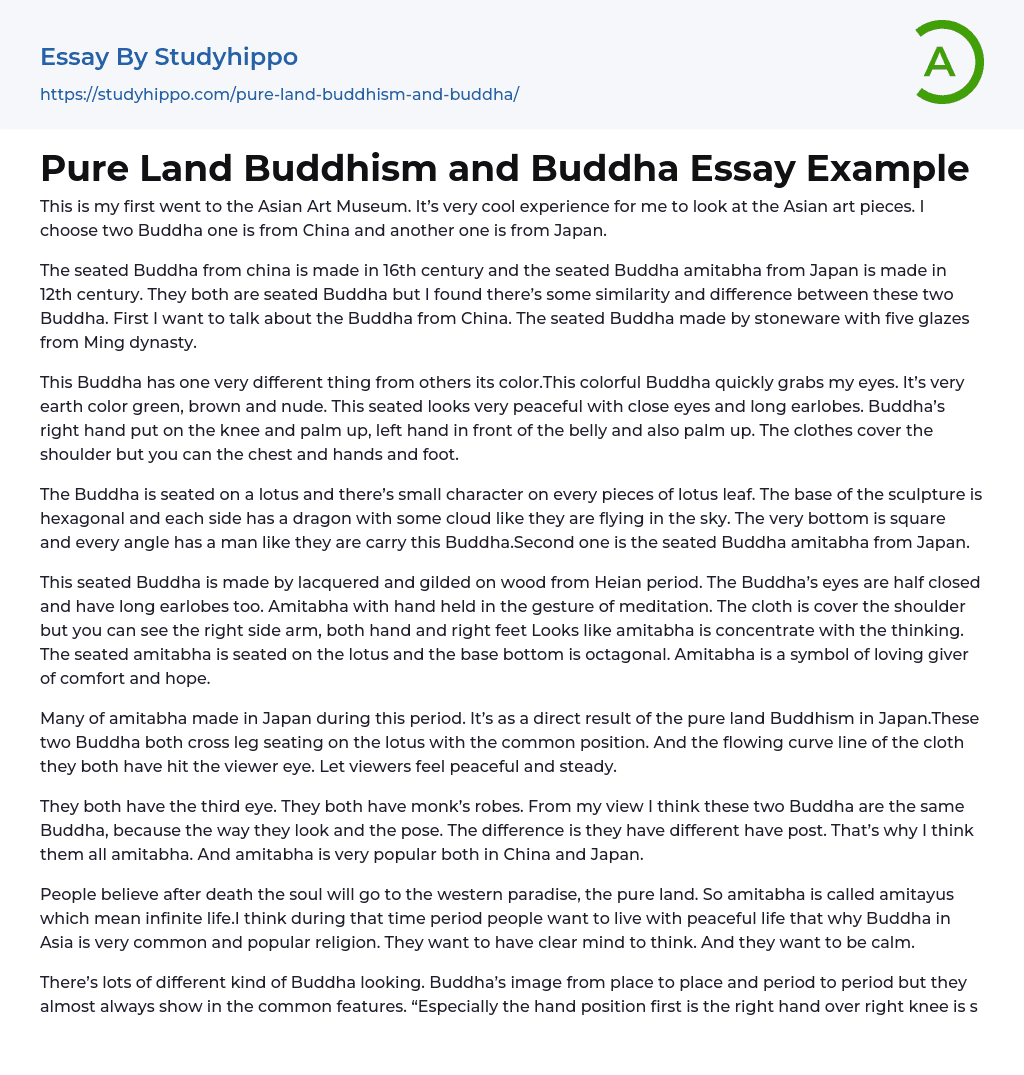My initial visit to the Asian Art Museum proved to be a fascinating experience as I explored the exquisite art pieces from Asia. Impressed by the diversity, I decided to select two Buddha sculptures - one from China and the other from Japan.
In regards to the seated Buddha figurines, there are two noteworthy pieces hailing from China and Japan. The Chinese Buddha was crafted during the 16th century and is comprised of stoneware and a quintet of glazes originating from the Ming dynasty. Alternatively, the Japanese Buddha, referred to as Amitabha, was created four centuries prior during the 12th century. Despite both being seated depictions of Buddha, there are discernible differences as well as similarities between them.
The Buddha depicted here stands out from others due to its vivid coloring. The natural hues of green, brown,
...and nude are eye-catching. The seated figure exudes peace with shut eyes and elongated earlobes while the right hand rests on the knee with an upward-facing palm. The left hand also faces upwards and is placed in front of the belly. While the shoulders are covered by clothing, the chest, hands, and feet remain visible.
The Buddha is depicted sitting on a lotus, with a small character on each lotus leaf. The sculpture's base is hexagonal, featuring a dragon on each side surrounded by cloud motifs. At the bottom, there is a square structure with a man on each corner as if they are carrying the weight of the Buddha. Another seated Buddha in the collection is the Amitabha statue from Japan.
This Heian period wooden sculpture of the seated Buddha features gilded and lacquered details. The Buddha's long earlobes accompany half-close
eyes. Meditative hand gestures portray Amitabha, who is draped in cloth over the shoulders, but with visible right-hand, right-foot depiction, implying deep concentration. The lotus-seated Amitabha rests on an octagonal base. Symbolizing hope and comfort, Amitabha represents a loving giver.
During this period, a number of Amitabha sculptures were produced in Japan as a result of the influence of Pure Land Buddhism. Both Buddhas on each sculpture are depicted seated in the lotus position, with flowing curves on their clothing that create a calming and stable effect on the viewer.
Although the Buddha statues are depicted in different positions, both wear monk's robes and have a third eye. This leads me to believe that they represent the same figure, which I surmise to be Amitabha – a highly respected character in China and Japan.
Many people believe that Amitayus, which means 'infinite life', is connected with the idea of the soul moving to the pure land of western paradise following death. Buddhism's popularity in Asia arises from its capacity to satisfy individuals' yearning for a calm existence and tranquil state of mind.
The image of Buddha may have differences based on time and location, but certain common elements are typically present. One of these is hand positioning, which often involves placing the right hand over the right knee as a symbol of Buddha's call to Earth during his triumph over negative forces. Another position involves holding the right hand up with an outward-facing palm to provide reassurance. A third position entails holding both hands at chest level while turning invisible fingers in a circular motion that represents preaching or setting in motion the "wheel of doctrine," according to
an educational website focused on Asian culture. The significance of different hand positions can be seen in my chosen images of Buddha.
The Buddha in China is portrayed with a kind expression and his hands in a position that is referred to as the first or second hand position. On the other hand, the Buddha in Japan is depicted with a hand position that can be described as the third hand position, carrying a distinct symbolism.
- Gautama Buddha essays
- Karma essays
- Buddha essays
- Afterlife essays
- Atheism essays
- Bible essays
- Buddhism essays
- Christian Worldview essays
- Christianity essays
- Confession essays
- Cosmological Argument essays
- Deism essays
- Devil essays
- Existence of God essays
- Faith essays
- Freedom Of Religion essays
- God essays
- Hinduism essays
- Immortality essays
- Islam essays
- Jainism essays
- Jews essays
- Judaism essays
- Miracle essays
- Monk essays
- Monotheism essays
- New Testament essays
- Old Testament essays
- Pilgrimage essays
- Puritans essays
- Revelation essays
- Ritual essays
- Salvation essays
- Sin essays
- Sinners essays
- Soul essays
- Taoism essays
- Temple essays
- Theology essays
- Angel essays
- Spirituality essays




